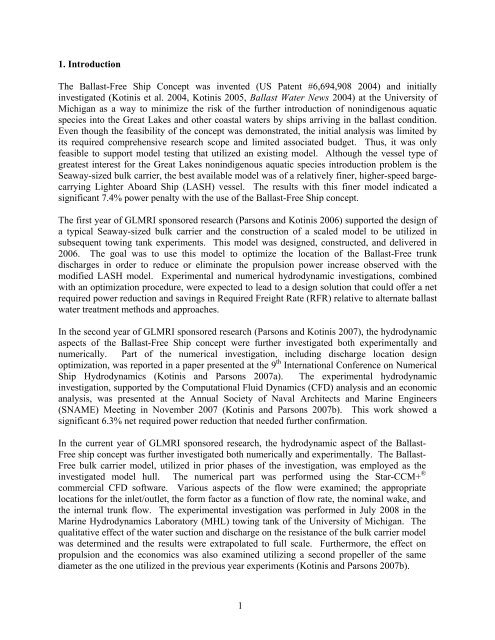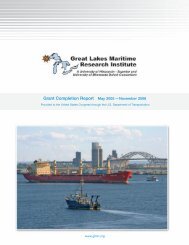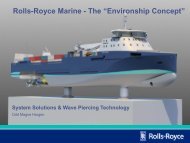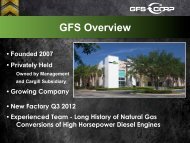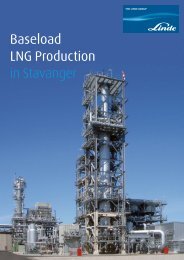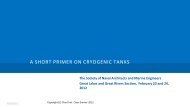Further Development and Optimization of the Ballast-Free Ship ...
Further Development and Optimization of the Ballast-Free Ship ...
Further Development and Optimization of the Ballast-Free Ship ...
You also want an ePaper? Increase the reach of your titles
YUMPU automatically turns print PDFs into web optimized ePapers that Google loves.
1. Introduction<br />
The <strong>Ballast</strong>-<strong>Free</strong> <strong>Ship</strong> Concept was invented (US Patent #6,694,908 2004) <strong>and</strong> initially<br />
investigated (Kotinis et al. 2004, Kotinis 2005, <strong>Ballast</strong> Water News 2004) at <strong>the</strong> University <strong>of</strong><br />
Michigan as a way to minimize <strong>the</strong> risk <strong>of</strong> <strong>the</strong> fur<strong>the</strong>r introduction <strong>of</strong> nonindigenous aquatic<br />
species into <strong>the</strong> Great Lakes <strong>and</strong> o<strong>the</strong>r coastal waters by ships arriving in <strong>the</strong> ballast condition.<br />
Even though <strong>the</strong> feasibility <strong>of</strong> <strong>the</strong> concept was demonstrated, <strong>the</strong> initial analysis was limited by<br />
its required comprehensive research scope <strong>and</strong> limited associated budget. Thus, it was only<br />
feasible to support model testing that utilized an existing model. Although <strong>the</strong> vessel type <strong>of</strong><br />
greatest interest for <strong>the</strong> Great Lakes nonindigenous aquatic species introduction problem is <strong>the</strong><br />
Seaway-sized bulk carrier, <strong>the</strong> best available model was <strong>of</strong> a relatively finer, higher-speed bargecarrying<br />
Lighter Aboard <strong>Ship</strong> (LASH) vessel. The results with this finer model indicated a<br />
significant 7.4% power penalty with <strong>the</strong> use <strong>of</strong> <strong>the</strong> <strong>Ballast</strong>-<strong>Free</strong> <strong>Ship</strong> concept.<br />
The first year <strong>of</strong> GLMRI sponsored research (Parsons <strong>and</strong> Kotinis 2006) supported <strong>the</strong> design <strong>of</strong><br />
a typical Seaway-sized bulk carrier <strong>and</strong> <strong>the</strong> construction <strong>of</strong> a scaled model to be utilized in<br />
subsequent towing tank experiments. This model was designed, constructed, <strong>and</strong> delivered in<br />
2006. The goal was to use this model to optimize <strong>the</strong> location <strong>of</strong> <strong>the</strong> <strong>Ballast</strong>-<strong>Free</strong> trunk<br />
discharges in order to reduce or eliminate <strong>the</strong> propulsion power increase observed with <strong>the</strong><br />
modified LASH model. Experimental <strong>and</strong> numerical hydrodynamic investigations, combined<br />
with an optimization procedure, were expected to lead to a design solution that could <strong>of</strong>fer a net<br />
required power reduction <strong>and</strong> savings in Required Freight Rate (RFR) relative to alternate ballast<br />
water treatment methods <strong>and</strong> approaches.<br />
In <strong>the</strong> second year <strong>of</strong> GLMRI sponsored research (Parsons <strong>and</strong> Kotinis 2007), <strong>the</strong> hydrodynamic<br />
aspects <strong>of</strong> <strong>the</strong> <strong>Ballast</strong>-<strong>Free</strong> <strong>Ship</strong> concept were fur<strong>the</strong>r investigated both experimentally <strong>and</strong><br />
numerically. Part <strong>of</strong> <strong>the</strong> numerical investigation, including discharge location design<br />
optimization, was reported in a paper presented at <strong>the</strong> 9 th International Conference on Numerical<br />
<strong>Ship</strong> Hydrodynamics (Kotinis <strong>and</strong> Parsons 2007a). The experimental hydrodynamic<br />
investigation, supported by <strong>the</strong> Computational Fluid Dynamics (CFD) analysis <strong>and</strong> an economic<br />
analysis, was presented at <strong>the</strong> Annual Society <strong>of</strong> Naval Architects <strong>and</strong> Marine Engineers<br />
(SNAME) Meeting in November 2007 (Kotinis <strong>and</strong> Parsons 2007b). This work showed a<br />
significant 6.3% net required power reduction that needed fur<strong>the</strong>r confirmation.<br />
In <strong>the</strong> current year <strong>of</strong> GLMRI sponsored research, <strong>the</strong> hydrodynamic aspect <strong>of</strong> <strong>the</strong> <strong>Ballast</strong>-<br />
<strong>Free</strong> ship concept was fur<strong>the</strong>r investigated both numerically <strong>and</strong> experimentally. The <strong>Ballast</strong>-<br />
<strong>Free</strong> bulk carrier model, utilized in prior phases <strong>of</strong> <strong>the</strong> investigation, was employed as <strong>the</strong><br />
investigated model hull. The numerical part was performed using <strong>the</strong> Star-CCM+ ®<br />
commercial CFD s<strong>of</strong>tware. Various aspects <strong>of</strong> <strong>the</strong> flow were examined; <strong>the</strong> appropriate<br />
locations for <strong>the</strong> inlet/outlet, <strong>the</strong> form factor as a function <strong>of</strong> flow rate, <strong>the</strong> nominal wake, <strong>and</strong><br />
<strong>the</strong> internal trunk flow. The experimental investigation was performed in July 2008 in <strong>the</strong><br />
Marine Hydrodynamics Laboratory (MHL) towing tank <strong>of</strong> <strong>the</strong> University <strong>of</strong> Michigan. The<br />
qualitative effect <strong>of</strong> <strong>the</strong> water suction <strong>and</strong> discharge on <strong>the</strong> resistance <strong>of</strong> <strong>the</strong> bulk carrier model<br />
was determined <strong>and</strong> <strong>the</strong> results were extrapolated to full scale. <strong>Fur<strong>the</strong>r</strong>more, <strong>the</strong> effect on<br />
propulsion <strong>and</strong> <strong>the</strong> economics was also examined utilizing a second propeller <strong>of</strong> <strong>the</strong> same<br />
diameter as <strong>the</strong> one utilized in <strong>the</strong> previous year experiments (Kotinis <strong>and</strong> Parsons 2007b).<br />
1


